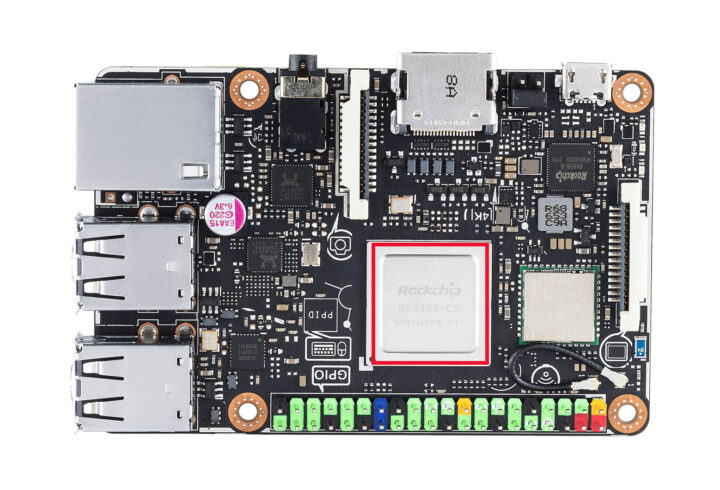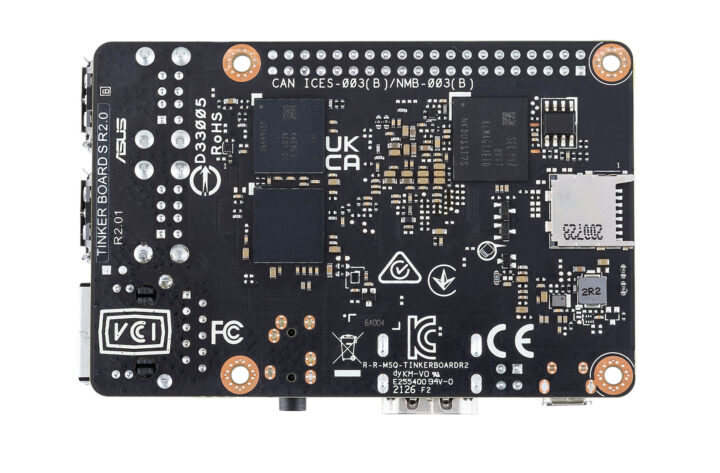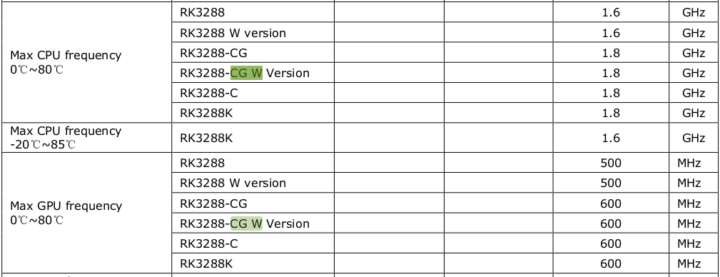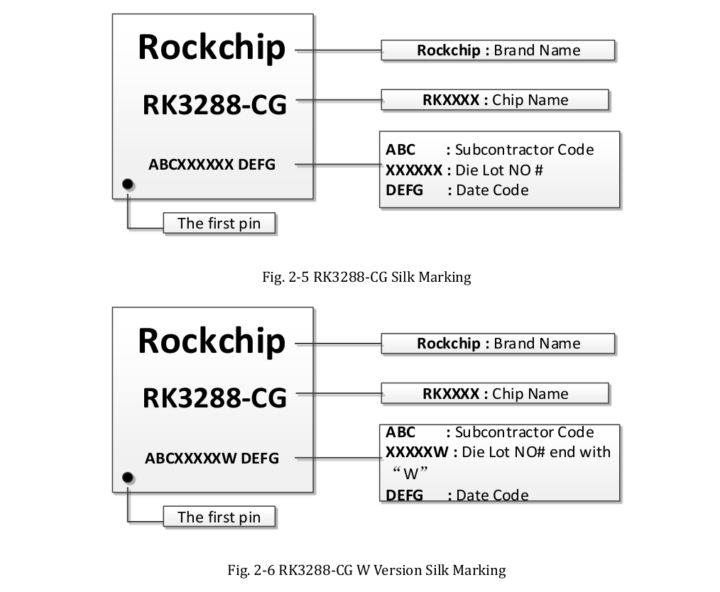ASUS Tinker Board S R2.0 is a revision of the original Tinker Board S board launched in 2018 with a 16GB eMMC flash. The R2.0 model relies on Rockchip RK3288-CG W quad-core Cortex-A17 processor and gets an upgrade to Bluetooth 4.2 from Bluetooth 4.0.
The rest of the specifications remain the same with 2GB DDR3, HDMI 2.0 and MIPI DSI video interface, a MIPI CSI camera interface, a 3.5mm audio jack, Gigabit Ethernet, a WiFi 4 and Bluetooth 4.x module, four USB 2.0 host ports, and a 40-pin color-coded Raspberry Pi compatible header.
 Tinker Board S R2.0 specifications:
Tinker Board S R2.0 specifications:
- SoC – Rockchip RK3288-CG.W quad-core ARM Cortex A17 processor up to 1.8 GHz with Mali-T764 GPU @ up to 600 MHz supporting OpenGL ES 1.1/2.0 /3.0, and OpenCL 1.1
- System Memory – 2GB dual-channel DDR3
- Storage – 16GB eMMC flash + microSD slot
- Video output & Display I/F
- 1x HDMI 2.0 up to 3840×2160 @ 30 Hz with HDMI CEC
- 1x 15-pin MIPI DSI supporting HD resolution
- Audio – 1x 3.5mm audio jack with plug-in detection and auto-switch; Realtek ALC4040 HD codec with 192KHz/24-bit audio
- Camera I/F – 1x 15-pin MIPI CSI connector
- Connectivity – Gigabit Ethernet, 802.11 b/g/n WiFi, Bluetooth 4.2 + EDR
- USB – 4x USB 2.0 host ports, 1x micro USB port (for power)
- Expansion Headers
- 40-pin Raspberry Pi compatible header with up to 28x GPIOs, 2x SPI, 2x I2C, 4x UART, 2x PWM, 1x PCM/I2S, 5V, 3.3V, and GND
- 2-pin contact point with 1x PWM signal, 1x S/PDIF signal
- 2-pin power-on-header
- Misc – Button, unpopulated fan header
- Power Supply – 5V/2-3A via micro USB port with support for low voltage detection
- Dimensions – 85.6 x 54 cm
- Weight – 55 grams
The Tinker Board S R2.0 and Tinker Board R2.0 (no eMMC flash) single board computers support the Debian-based TinkerOS sand Android 12, but I must have missed some changes, as some of the newer OS images are provided only for the R2.0 models unless it’s just for the different wireless module., or the original Tinker Board SBCs have been phased out.
It’s unclear when ASUS introduced the new R2.0 SBCs, but they are already for sale on various websites as we’ll explain below, and I can see the Rockchip RK3288-GC W was added to the datasheet in May 2018. I’ve never heard about it, but it looks like it supports higher CPU (1.8 GHz) and GPU (600 MHz) frequencies compared to the earlier RK3288 introduced in 2024, or at least does so in a more stable manner.
I can also see the RK3288-CG processor, but it’s unclear how it differs from the RK3288-CG W, as the only difference in the datasheet is the way the chips are marked: with a different die lot.
The Tinker Board S R2.0 can be purchased on Amazon, eBay, and various distributors, but the prices I’m seeing ($135+) do not really make it attractive, even at a time of relative supply shortage of Raspberry Pi 4 SBCs. Additional information may be found on the product page.

Jean-Luc started CNX Software in 2010 as a part-time endeavor, before quitting his job as a software engineering manager, and starting to write daily news, and reviews full time later in 2011.
Support CNX Software! Donate via cryptocurrencies, become a Patron on Patreon, or purchase goods on Amazon or Aliexpress. We also use affiliate links in articles to earn commissions if you make a purchase after clicking on those links.








The base RK3288 were already advertised as 1.8-2.2G from many vendors, though sometimes limited to 1.6 by the BSP kernel, and often 1.8. It’s a bit dated now however, and the powering issues over the micro-USB port are not gone on this board.
It’s hard to get excited by a quad A17 in 2023. And, yeah, if you thought the rpi boards had power issues, you need to avoid the Tinerboards like the plague. (Then again, if the last few years are any evidence, humans aren’t very good at avoiding plagues)
This really isn’t attractive at all, A17 are old cores and are two generations behind A72s.
Yeah, it would be a considerably faster than A53s but those are little cores…
In fact no, A17 are as good as A72 at same frequency, with a more or less similar pipeline. The only thing is that these are 32-bit cores, that nobody wants to run 32-bit ARM nowadays due to the myriad of variants that tends to force everyone to use the lowest common denominator (i.e. idiv is disabled, maybe even neon etc), that it lacks the crypto extensions that could make it perform as bad as an RPi4 on many modern workloads, and of course, it’s just 2GB RAM which is a bit tight for modern distros. Plus when you remember how hard it was to cool an RK3288 and the issues with heating micro-USB connectors, I wouldn’t see buying this nowadays as a good idea. I still have 9 MIQIs on my desk from my older build farm, and I almost never use them anymore. They were great devices in 2016.
That doesn’t seem to be true.
Compare Geekbench v5 scores for RK3288 vs RP4
https://browser.geekbench.com/v5/cpu/search?utf8=%E2%9C%93&q=RK3288
(there are some that are straight from Tinker Board on Linux which is a bit higher due to 1800 MHz clocks)
https://browser.geekbench.com/v5/cpu/search?utf8=%E2%9C%93&q=Raspberrypi+4
It doesn’t seem like the A17 gets close to A72 in single thread. Multi-thread is much closer and likely because of the memory system bottleneck.
It depends on the workloads. When I did the comparison on build time (http://wiki.ant-computing.com/Choosing_a_processor_for_a_build_farm#Results) I found the RK3288 at 1.992 GHz cross-compiling a reference workload for x86_64 in 17.6s, while the RPi at 2.0 GHz was compiling it in 21.6s in 64 bits mode or 16.3s in 32 bits mode. So the RK3288 at same frequency was 22.7% faster than the RPi4 running in 64 bits mode, and 7.5% slower than the RPi4 running in 32 bits mode. I don’t consider a 7.5% difference at same frequency that huge a difference to be honest, especially when you see that the RPi itself is 25% slower in 64-bit than in 32-bit!
You has same L1 L2 cache for 32 and 64
So that will be major source
Yes I’m well aware, but I mentioned it to remind that the hardware itself isn’t everything given that the same hardware used natively or in compatibility mode can show very different performance.
That’s pretty weird, it’s generally faster in 64-bits mode as it has access to more registers and new extensions. Most of the time that I went from 32 -> 64, it either had some performance uplift or same perf.
No, that’s pretty common. You don’t have condition flags on instructions anymore in 64-bits, you don’t have thumb2 which provides 20-30% code compaction that increases L1 efficiency, loading an immediate value into a register takes more instructions, calling functions and pushing registers in the stack requires twice the memory bandwidth, etc. I have yet to see a single case where *the same* code is faster on A64 than it is on A32. When you can benefit from extensions however it makes a difference. E.g. crypto. Also in A64 you have idiv by default, and toolchains used not to always produce it in A32 despite some processors having it (armada XP had it, 370 had it in thumb mode only, cortex a15/a17 and all 5x/7x have it in 32-bit mode). Interactions between VFP and ARM are better in 64-bit as well. But when you get back to plain generic code such as a compiler, even on 64-bit I continue to build them in 32-bit because it runs 15-20% faster even when used to produce code for a 64-bit platform (and yes I test and compare every time before deciding to install the compat32 libs and engaging into that route).
$135+ for that when so many great rk3588 boards are in that space which one do you choose…
In fact OPI5 4gb is $75!
Yeah exactly – why didn’t they just go with the 3588 and why such paltry RAM…?